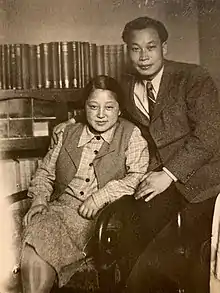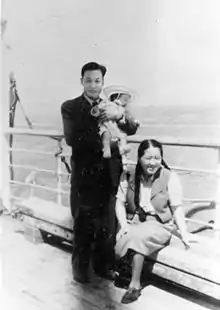Qian Sanqiang
Qian Sanqiang (Chinese: 钱三强; October 16, 1913 – June 28, 1992), also known as Tsien San-Tsiang, was a Chinese nuclear physicist. Due to his central role in the development of China's nuclear industry and nuclear weapons program, he is referred to as China's "father of the atomic bomb".[1][2]


Biography

A native of Huzhou, Zhejiang Province, China, Qian was born in Shaoxing, the son of the scholar Qian Xuantong. Qian attended Peking University and Tsinghua University, graduating in 1936 in the same class as his future wife He Zehui. Qian went to France in 1937. He studied in the Collège de Sorbonne and Collège de France, doing research under Frédéric Joliot-Curie and Irène Joliot-Curie. He obtained the French doctorate in 1940.[1]
Qian returned to China in 1948 with his wife, the nuclear physicist He Zehui,[3] where he took up a professorship at the Tsinghua University and in 1950 founded the Institute of Modern Physics of the Chinese Academy of Sciences (CAS), today known as the China Institute of Atomic Energy.[1]
In 1954 he joined the Communist Party of China. He served successively as Director of the Institute of Modern Physics under the Chinese Academy of Sciences, Vice-Minister of the No. 2 Ministry of the Machine-building Industry, Vice-President of the Chinese Academy of Sciences and honorary Chairman of the China Association for Science and Technology.
Qian made outstanding contributions to the establishment of nuclear science in the People's Republic of China and to the development of the PRC's atomic and hydrogen bombs.[3]
References
- "那年今日丨中国的"原子弹之父"钱三强诞生_科技湃_澎湃新闻-The Paper". www.thepaper.cn. Retrieved 2017-10-16.
- "Father of China's atom bomb: Qian Sanqiang". China Daily. Retrieved 2017-10-16.
- Kristof, Nicholas D. (3 July 1992). "Qian Sanqiang, Chinese Physicist On Atom Bomb Team, Dies at 79". New York Times. Retrieved 10 February 2015.
| Academic offices | ||
|---|---|---|
| Preceded by Chen Weida |
President of Zhejiang University 1979–1982 |
Succeeded by Yang Shilin |